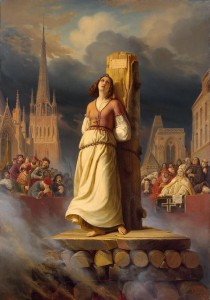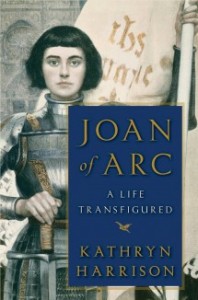 23rd May, 1430–Joan of Arc was captured by the Burgundians while leading an army to defend Compiègne against an English siege. The battle formed part of the Hundred Years’ War, a series of conflicts which pitted the rulers of the Kingdom of England against the House of Valois for control of the French throne. In the description of Burgundian, Georges Chastellain describes her capture thus: “Then the Maid [Joan of Arc], surpassing the nature of a woman, took on a great force, and took much pain to save her company from defeat, remaining behind as the leader and as the bravest of the troop. But there fortune permitted for the end of her glory and for the last time that she would ever carry arms. An archer, a rough and very sour man, full of much spite because a woman, who so much had been spoken about, should have defeated so many brave men, as she had done, grabbed the edge of her cloth-of-gold doublet, and threw her from her horse flat to the ground.” Following her capture, she was sold to the English, put through a politically motivated trial and later burnt at the stake for heresy.
23rd May, 1430–Joan of Arc was captured by the Burgundians while leading an army to defend Compiègne against an English siege. The battle formed part of the Hundred Years’ War, a series of conflicts which pitted the rulers of the Kingdom of England against the House of Valois for control of the French throne. In the description of Burgundian, Georges Chastellain describes her capture thus: “Then the Maid [Joan of Arc], surpassing the nature of a woman, took on a great force, and took much pain to save her company from defeat, remaining behind as the leader and as the bravest of the troop. But there fortune permitted for the end of her glory and for the last time that she would ever carry arms. An archer, a rough and very sour man, full of much spite because a woman, who so much had been spoken about, should have defeated so many brave men, as she had done, grabbed the edge of her cloth-of-gold doublet, and threw her from her horse flat to the ground.” Following her capture, she was sold to the English, put through a politically motivated trial and later burnt at the stake for heresy.
—————————————————————————————————————————————-
 7th May, 1429 AD– Joan of Arc ended the Siege of Orléans, pulling an arrow from her own shoulder and returning, wounded, to lead the final charge. The victory marked a turning point in the Hundred Years’ War between France and England. It was Joan of Arc’s first major military victory and the first major French success to follow the crushing defeat at Agincourt in 1415. It is believed that the English regent, John Plantagenet, would have succeeded in realizing Henry V’s dream of conquering all of France if Orléans had fallen.
7th May, 1429 AD– Joan of Arc ended the Siege of Orléans, pulling an arrow from her own shoulder and returning, wounded, to lead the final charge. The victory marked a turning point in the Hundred Years’ War between France and England. It was Joan of Arc’s first major military victory and the first major French success to follow the crushing defeat at Agincourt in 1415. It is believed that the English regent, John Plantagenet, would have succeeded in realizing Henry V’s dream of conquering all of France if Orléans had fallen.
—————————————————————————————————————————————-
 29th April, 1429 AD – Joan of Arc arrived to relieve the Siege of Orleans, a battle which marked a turning point in the Hundred Years’ War between France and England. It was Joan of Arc’s first major military victory and the first major French success to follow the crushing defeat at Agincourt in 1415. It is believed that the English regent, John Plantagenet, would have succeeded in realizing Henry V’s dream of conquering all of France if Orléans had fallen. For years, vague prophecies had been circulating in France concerning an armored maiden who would rescue France. As a result, when word reached the besieged citizens of Orléans that Joan of Arc had arrived, expectations and hopes were high. For half a year the English had been winning, but their siege collapsed within only nine days after Joan’s arrival.
29th April, 1429 AD – Joan of Arc arrived to relieve the Siege of Orleans, a battle which marked a turning point in the Hundred Years’ War between France and England. It was Joan of Arc’s first major military victory and the first major French success to follow the crushing defeat at Agincourt in 1415. It is believed that the English regent, John Plantagenet, would have succeeded in realizing Henry V’s dream of conquering all of France if Orléans had fallen. For years, vague prophecies had been circulating in France concerning an armored maiden who would rescue France. As a result, when word reached the besieged citizens of Orléans that Joan of Arc had arrived, expectations and hopes were high. For half a year the English had been winning, but their siege collapsed within only nine days after Joan’s arrival.
—————————————————————————————————————————————-
 30th May, 1431 AD-The 19-year-old Joan of Arc was burned at the stake for heresy by an English-dominated tribunal. Before her death, a guard of English soldiers, who laughed at her as she made her frantic, last minute prayers, surrounded the weeping Joan. One English soldier took pity on the girl and handed her a hastily made wooden cross moments before she was tied to the stake. She kissed it and put it into her bosom. During her burning, a Dominican friar consoled her by holding up a crucifix for her to gaze upon as she died. Even as she was burned, Joan did not recant. To the end, she continued to claim that the voices she had heard all her life were divine in nature. In later years, the executioner claimed that Joan’s heart resisted the flames, and had been found intact among the ashes. Even in death, Joan continued to maintain a powerful hold over people’s imaginations. In 1450, Charles VII went to Rouen and demanded an investigation into Joan’s execution. Later, Pope Calixtus III annulled Cauchon’s 1431 verdict declaring Joan a heretic, and on May 16, 1920, Pope Benedict XV made Joan of Arc a saint. In June of that year, the French Parliament declared a national holiday in Joan’s honour.
30th May, 1431 AD-The 19-year-old Joan of Arc was burned at the stake for heresy by an English-dominated tribunal. Before her death, a guard of English soldiers, who laughed at her as she made her frantic, last minute prayers, surrounded the weeping Joan. One English soldier took pity on the girl and handed her a hastily made wooden cross moments before she was tied to the stake. She kissed it and put it into her bosom. During her burning, a Dominican friar consoled her by holding up a crucifix for her to gaze upon as she died. Even as she was burned, Joan did not recant. To the end, she continued to claim that the voices she had heard all her life were divine in nature. In later years, the executioner claimed that Joan’s heart resisted the flames, and had been found intact among the ashes. Even in death, Joan continued to maintain a powerful hold over people’s imaginations. In 1450, Charles VII went to Rouen and demanded an investigation into Joan’s execution. Later, Pope Calixtus III annulled Cauchon’s 1431 verdict declaring Joan a heretic, and on May 16, 1920, Pope Benedict XV made Joan of Arc a saint. In June of that year, the French Parliament declared a national holiday in Joan’s honour.
—————————————————————————————————————————————–
7th July, 1456, a retrial verdict acquitted Joan of Arc of heresy 25 years after her death. The aim of the trial was to investigate whether the trial of condemnation and its verdict had been handled justly and according to canon law. Joan of Arc, otherwise known as The Maid of Orléans, is considered a heroine of France for her instrumental role in leading France against the English in the Hundred Years’ War. Nineteen-year-old Joan of Arc, who claimed to have received visions of the Archangel Michael, Saint Margaret and Saint Catherine, was burned at the stake in 1431 for heresy by an English-dominated tribunal. To the end, she continued to claim that the voices she had heard all her life were divine in nature. Even in death, Joan continued to maintain a powerful hold over people’s imaginations. In 1450, Charles VII went to Rouen and demanded an investigation into Joan’s execution. In 1456, Pope Calixtus III annulled Cauchon’s 1431 verdict that declared Joan a heretic, and on May 16, 1920, Pope Benedict XV made Joan of Arc a saint. In June of that year, the French Parliament declared a national holiday in Joan’s honour.
—————————————————————————————————————————————-
 6th January, 1412–Joan of Arc (Jeanne d’Arc), French martyr, was born to a peasant family at Domrémy in north-east France. For years, vague prophecies had been circulating in France concerning an armored maiden who would rescue France from England’s attempt to gain control of the French throne during the Hundred Years’ War. And then appeared Joan, a young woman driven by saintly visions who led the French in numerous battles against the English. Many believe that the English regent, John Plantagenet, would have succeeded in realizing Henry V’s dream of conquering all of France had Joan of Arc not led a force which saved the besieged citizens of Orléans, and which marked a turning point in the war. Captured a year after the famous Siege of Orléans, Joan was branded a heretic, put through a politically motivated show trial, and burned at the stake at the age of only 19. She was canonized as a saint 500 years later, on May 16, 1920.
6th January, 1412–Joan of Arc (Jeanne d’Arc), French martyr, was born to a peasant family at Domrémy in north-east France. For years, vague prophecies had been circulating in France concerning an armored maiden who would rescue France from England’s attempt to gain control of the French throne during the Hundred Years’ War. And then appeared Joan, a young woman driven by saintly visions who led the French in numerous battles against the English. Many believe that the English regent, John Plantagenet, would have succeeded in realizing Henry V’s dream of conquering all of France had Joan of Arc not led a force which saved the besieged citizens of Orléans, and which marked a turning point in the war. Captured a year after the famous Siege of Orléans, Joan was branded a heretic, put through a politically motivated show trial, and burned at the stake at the age of only 19. She was canonized as a saint 500 years later, on May 16, 1920.
—————————————————————————————————————————————-
*Images and fun facts from: http://www.ancient-origins.net/
Book Cover image from: http://www.kathrynharrison.com/books/joan-of-arc-a-life-transfigured

Death entered the world through the disobedience of one evil woman, Eve, and so death spread to all mankind.
Eternal Life entered the world through the obedience of one righteous woman, Joan of Arc.
“I AM [Je suis] a good Christian.” — Joan of Arc.
The passing of the salvation buck STOPS with Joan of Arc.
None of us has remained in the love of Jesus by keeping his commandments.
Jesus kept his Father’s commandments and remained in his love.
Joan kept the commandments of Jesus and remained in his love.
And Joan has done so on our behalf.
WHAT’S UR NAME? I NEED THE AUTHOR NAME FOR MY HISTORY PROJECT, HUN💅
id put “university of oregon” since there isnt an author cuz thats what i did
I NEED IT AS WELL!!!! SOMEONE PLESE GIVE ME THE NAME!!!!!!!!!!!!!!!!!!!
Wow we all found a great history paper 😂
tstoto
tstoto
tstoto
tstoto
Holah World.